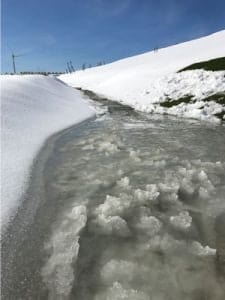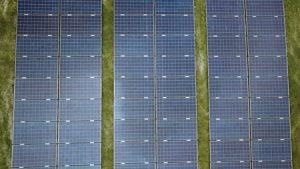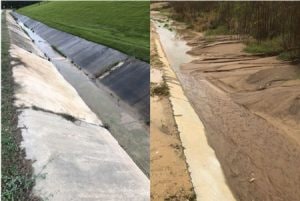An engineered synthetic turf system provides long-lasting, geotechnically stable and environmentally friendly final cover system that significantly reduces construction time and maintenance costs while providing an ideal foundation for solar panel deployment.
By Krista Willey

The very first engineered synthetic turf final cover system, called ClosureTurf, was installed on an MSW landfill in Louisiana in 2007. Since then, approximately 2,000 acres of this system has been installed on additional MSW, industrial, CCR landfills and impoundments in a wide assortment of climactic and topographic conditions. This year marks the 10-year anniversary of the first installation and the decade of progress that the system has had as a viable final closure solution, specifically related to weather-resistance and environmental impacts.
Geosynthetic Turf Components
An engineered synthetic turf system is a three-component system comprised of a structured geomembrane, an engineered turf and a specified infill. The structured geomembrane provides both drainage and high interface friction for stability. It serves as the barrier layer to minimize infiltration through the cover system into the waste. The engineered turf is made of synthetic grass blades tufted into two layers of geotextile backing. It is the protection layer that covers and protects the underlying geomembrane from UltraViolet (UV) degradation and wind uplift. The specified infill provides additional UV protection and allows the system to withstand traffic loads.
Severe Weather-Proven Durability
Many of the engineered synthetic turf system installations have experienced significant, if not historic, weather events, including hurricane-force winds and record-setting rainfall. Some of these sites have even experienced multiple events.
Wind tunnel testing was conducted at Georgia Tech Research Institute to evaluate the wind uplift of engineered turf. Wind actually created a downward force on the turf and it resisted a hurricane-force wind of 120 mph without being lifted. Several project installations have experienced significant, if not historic, weather events, including hurricane-force winds and record setting rainfall. A closure project in South Carolina endured a 1,000-year rain event when a hurricane swept through the area and a Florida panhandle project experienced a historic 500-year storm event where 5.68 inches fell in a single hour (26 inches total in a 24-hour period). No damage to the system was incurred.
Additionally, northern installations with an engineered turf system have also provided opportunities to evaluate its performance in areas that encounter cold, high wind and snow conditions. Geosynthetics perform exceptionally well in each of these extreme weather condition scenarios.

Soil Construction Factors
Eliminating the need for a two-foot soil and vegetative cover layer improves safety while reducing the carbon footprint of the closure as there is no need to transport soil to the site. This means the removal of thousands of trucks from local roads as geosynthetic turf closures eliminate the need for approximately 550 truck trips (275 round trips) per acre that would otherwise be needed to transport soil to and from a borrow site. Less equipment also means reducing the carbon footprint of the closure by approximately 80 percent compared to traditional soil/vegetative covers. The reduction in size, number and duration of equipment also means an overall increase in safety on both the project site and local roads, as well as reduction of dust at the site, mud on the roads, and noise impacts to the surrounding community. Most traditional closures also require destruction of land for project soil sources, resulting in additional environmental impact and loss of future land use.
Reduced Environmental Impacts
When considering a final cover system for a landfill, it is not only important to keep water out of the waste, you must also ensure that nothing detrimental comes off the surface and lands in the water carried off your site. Considering the average size of landfills, opportunity exists for significant sediment pollution through erosion that is often an inherent part of traditional soil covers. Geosynthetic turf systems provide clean runoff with very low turbidity because it does not have a soil layer, except for the thin (0.5-inch thick) layer of sand infill. The sand acts as a natural filter as the water moves down the slope and channeling areas. As a result, sites have experienced a 90 percent reduction in turbidity resulting in cleaner water. The system also significantly reduces sediment loading to surrounding channels and sedimentation detention basins either onsite or offsite. This produces a positive impact on overall storm water quality, allowing effluent levels to meet (or be well below) the regulatory turbidity limits. Most importantly, it can consistently provide repeatable water quality results for every design storm event.

Photos courtesy of Watershed Geo.
In areas of channelized flow (bench drains, down chutes and perimeter channels), the geosynthetic turf system can be infilled with a fiber reinforced high-strength concrete matrix instead of sand. This specialized pozzolanic infill created specifically for storm water applications will flex and move with typical differential settlements that occur on permanent covers. It provides superior hydraulic performance capable of handling high shear stress and large flows resulting in very high velocities.
Reduced Maintenance and Post-Closure Costs
Geosynthetic systems require very low post-closure maintenance compared to alternative soil systems. The cost of maintenance is estimated to be as much as 90 percent less as a result of reduction in maintenance activities including vegetation, mowing, fertilization, irrigation, re-vegetation, erosion repairs and stormwater pond cleaning associated with traditional soil covers. Common erosion, stormwater and siltation problems are prevented—even during severe weather events such as intense rainfall, hurricane force winds and earthquakes. Further, it protects against driving forces, and severe weather conditions such as drought and heat.
Post-Closure Beneficial Use: Renewable Energy
Installing solar generation on capped landfills has proven an effective way to deploy large systems on typically unused space. Landfill owners are given the opportunity to generate revenue from what might be otherwise undevelopable land. Such sites are usually located near roads and electricity distribution infrastructure. Areas with larger populations tend to have high energy demand. Opportunities exist to lease the land, sell energy to a local utility and/or generate state renewable energy credits (SRECs).
Challenges to deploying solar panels on vegetated caps include fugitive dust, grass clippings and potential damage from mowing equipment. Additionally, panel systems might move or break due to settling caused by erosion impacts to a vegetated cap.
The engineered synthetic turf system provides the ideal foundation for capping environmental waste and significantly reduces the O&M expenses related to vegetation and erosion. There is no rebuilding of slopes, mowing or seeding required. Panels operate in a clean environment and are easily accessible. Best of all, it allows for installation of panels on slopes in addition to top decks for maximum output.
Upright solar panels have been successfully deployed on numerous synthetic cap closure sites across the U.S. Recently, a unique patented approach to maximizing solar collection at landfills and impoundments was demonstrated. The solar system combines the most advanced, proven panel technology with a rackless, direct surface attachment system that can be used on the top decks and side slopes of a geosynthetic turf foundation. This new slope panel technology system increases the power output by as much a three times per unit area compared to traditional arrays.
Closing
An engineered synthetic turf system is a proven technology that solves problems that have been plaguing the industry for decades. It addresses landfill stability and erosion problems by providing a long-lasting, geotechnically stable and environmentally friendly final cover system that significantly reduces construction time and maintenance costs while providing an ideal foundation for solar panel deployment. | WA
Krista Willey is Vice President of Marketing at Watershed Geo, an environmental solutions company offering unparalleled geosynthetic options for both civil and environmental applications for erosion control, soil stabilization and waste containment. Solutions include, ClosureTurf®, a final closure technology, HydroTurf®, a revetment technology for storm water applications and VersaCap®,an immediate cover for erosion, leachate and gas control. Krista can be reached at [email protected] or visit www.watershedgeo.com.
